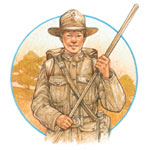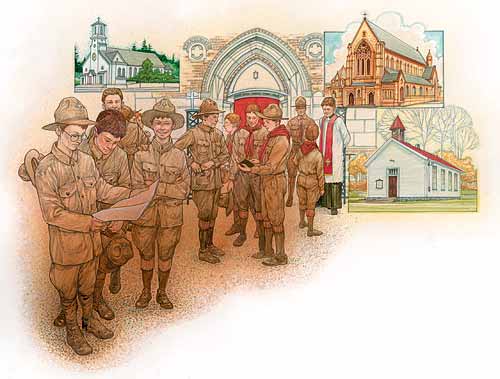
The Way It Was
Edited by Robert Peterson
Illustration by Bill Basso
The Beginnings of a Partnership
Since Scouting's early days, churches and other religious bodies have played a key role in the movement's steady growth.
The Boy Scouts of America grew explosively after its birth in February 1910. Membership went from 39,000 boys in 1913 (the first year they were counted) to 144,000 in 1915, and 281,000 in 1917.
A chief reason for the rapid growth was the welcome provided by churches and other religious groups. While official sponsorship of each troop by an institution, church or otherwise, was not required until 1919, nearly half of all early units met in churches. For the first few years, more Scoutmasters were clergymen than any other profession or trade.

Religious bodies are still the leaders among chartered organizations, accounting for 61 percent of troops, packs, and Venturing crews in 2002, the last year for which membership statistics are available.
On the other hand, although the BSA has not recorded the occupations of its unit leaders in recent years, it is almost certain that clergymen would not be in the top echelon today.
A special appeal
In 1910 Protestant churches had many organizations for youth, with such names as Christian Endeavor, the Epworth League, and the Baptist Young People's Union of the Southern Baptist Convention. However, their appeal was limited for boys who sought adventure and action rather than spiritual sustenance, and only the Young Men's Christian Association offered a taste of "muscular Christianity."
So Boy Scouting's promise of outdoor fun and camaraderie, and its call on boys to do their duty to God, made it the favored youth organization of many Protestant churches.
Typical of these was the First Presbyterian Church in Auburn, N.Y. The pastor, Dr. William H. Hubbard, heard about the Scouting program in September 1910, seven months after the BSA was born. He decided he wanted it in his church, and assigned his assistant, a seminary student, to start a troop.
"Dr. Hubbard was a great lover of young people," said Harold J. Short, one of the first Scouts in Auburn.
Another such church was Emmanuel Lutheran on New York City's Staten Island. In 1916 the Rev. Herman A. Meyer became pastor.
"I found no decent youth program at Emmanuel Lutheran," he remembered many years later, "so we took the Boy Scout program and used that. I followed the Handbook for Boys. I had to learn it myself, and I just stayed a little ahead of the boys in the book."
A year later, the Rev. John D. Clinton, who had learned about Scouting while he was a theological student at Boston University, introduced the program at the Methodist church in South Walpole, Mass.
"I did not register the troop for a year," he recalled, "but we had handbooks and all our equipment, and we were not asked whether we were registered." Like most of the early troops, his Scouts met once a week at the church and hiked or camped overnight once a month.
'A Scout is reverent'
James E. West, the first Chief Scout Executive, was responsible, at least in part, for the great interest churches had in Scouting.
Robert S.S. Baden-Powell, the British founder of Scouting, did not include reverence for God in his Scout Law. But at West's urging, the BSA adopted "A Scout is reverent" as the 12th point of the American Scout Law in 1911 because, he explained later, "I felt...that there is nothing more essential in the education of the youth of America than to give them religious instruction."
Most Protestant churches agreed and heartily endorsed Scouting for their youth.
Roman Catholics were slower to adopt the program, although there were troops in a few Catholic churches in the earliest days. Some Catholics feared the influence of the YMCA, a predominantly Protestant organization, which sponsored many of the pioneering troops.
However, when the charge was made in 1912 that Catholics were barred from leadership in the BSA, James E. West vehemently denied it. He told Boys' Life magazine that Catholics held top offices in several councils and that many Catholics, including priests, were Scoutmasters.
"This organization is not Protestant, nor is it Catholic, nor is it Hebrew," West said, "but it is a character-building organization for boys, to be used by all religions and institutions who can see in it a means of helping and assisting the boys of their communities."
Such reassurances helped allay fears of the Catholic hierarchy, and in 1917 several archbishops endorsed Scouting. One of them, William Henry Cardinal O'Connell of Boston, did so with the understanding that "there shall be distinctly Catholic troops under a Catholic Scoutmaster, and that there shall be a chaplain appointed by the proper ecclesiastical authority for each Catholic troop."
Jewish synagogues were slow to promote Scouting during the BSA's first five years. Only 40 synagogues were among the sponsors of the 7,375 troops across the country in 1915—less than 1 percent. From 1916 on, however, Jewish institutions increased their use of the Scouting program and today Scouting is flourishing in Jewish communities.
Some Jewish boys joined church-backed troops, but others like Harry Weiner of Lynn, Mass., were forbidden to do so by parents.
"I got all set up to join, but my mother wouldn't hear of my going into a church," he remembered. Later Weiner was the only Jewish Scoutmaster in that area for 20-odd years.
The Church of Jesus Christ of Latter-day Saints (Mormon) became the first religious body to endorse Boy Scouting for its youth, even though the LDS Church already had an organization for boys, the Young Men's Mutual Improvement Association, in each of its wards (parishes or congregations). In 1913 each MIA formed a troop.
Today, LDS churches charter almost 35,000 packs, troops, and Venturing crews, with more than 399,000 youth members at last count. That's almost three times as many units as the runner-up, the United Methodist Church.
But because LDS units tend to be much smaller than average, the United Methodists serve about the same number of youth.
Robert Peterson is the author of The Boy Scouts: An American Adventure.
May - June 2004 Table of Contents
Copyright © 2004 by the Boy Scouts of America. All rights thereunder reserved; anything appearing in Scouting magazine or on its Web site may not be reprinted either wholly or in part without written permission. Because of freedom given authors, opinions may not reflect official concurrence.